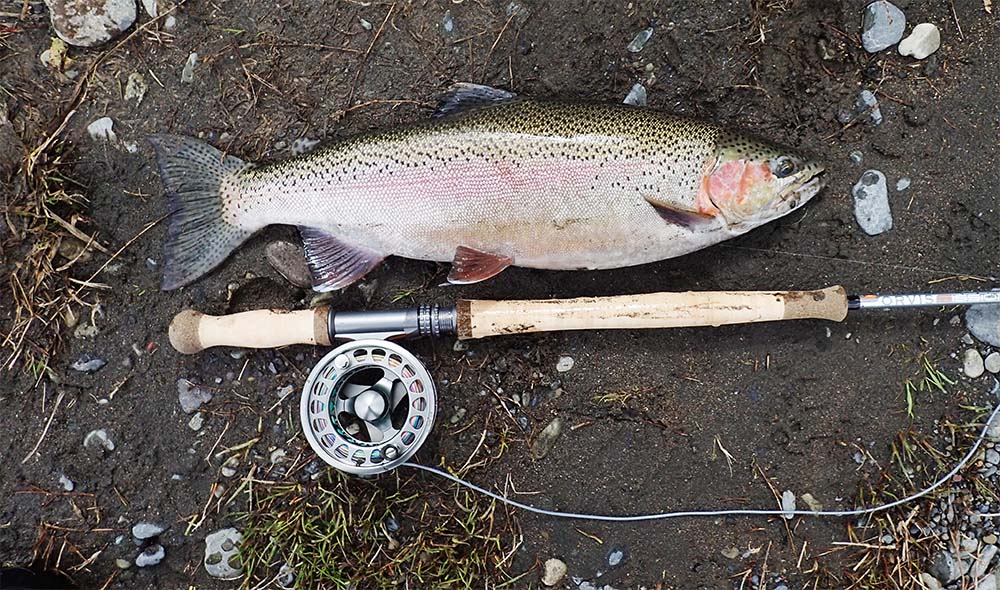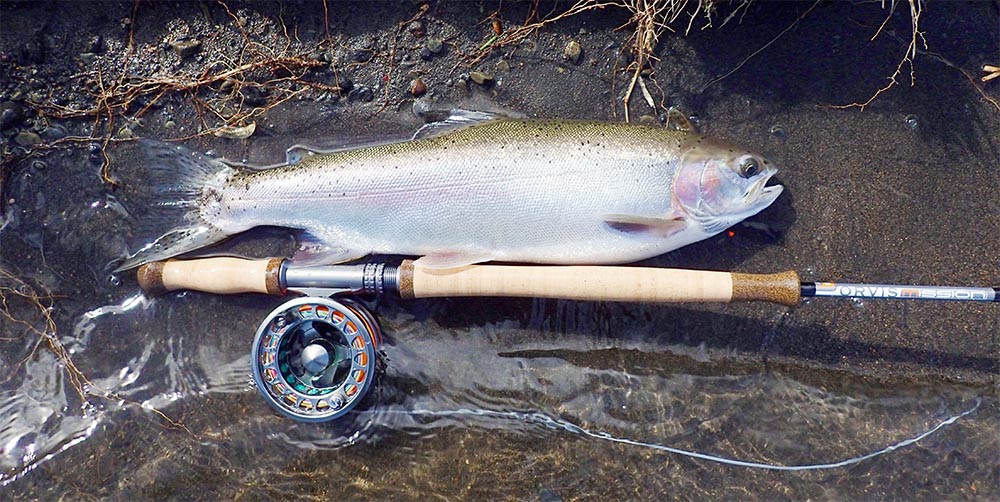Orvis Mission 12 foot 5wt Rod Review
Orvis added a 12 ft 5wt to their Mission series when I was looking for a second double handed rod in 2020 to compliment my 4wt Sage Trout Spey HD. I was after a rod that would be better suited to larger rivers and fresh run fish greater than 5 lb, and the new Mission certainly looked the part.
Out of the tube
Mission two-handers are built on the technology developed for the Helios 3 single handers.
The fit and finish on the Orvis Mission 5wt is exceptional. The cork is excellent, the thread wraps and epoxy work are second to none, and the machined Type III anodised down locking aluminium real seat with self indexing slide band and double rings is a standout feature.
The blank is painted matt olive and the thread wraps are the same colour as the blank, with a single orange accent at the base. I like the understated colour scheme.
The 5wt Mission is 8 inches longer than my Sage Trout Spey HD 4wt, and the blank diameter is considerably larger at the butt.
A Danielsson L5W 6nine fly reel was a great fit on this rod in regard to both balance and looks.
On the water
Orvis line recommendations for the Mission 12 ft 5wt are 360 grains for Skagit and 300 grains for Scandi. The recommended grain window is 300 - 380 grains.
I tried a number of heads, including:
• Scientific Anglers Skagit Lite intermediate head - 330 grains,
• Airflo Skagit Scout - 360 grain
• Rio Skagit Max Power heads - 350 and 375 grains,
• Scientific Anglers Scandi Lite - 300 grains
• Rio Scandi Body - 325 grains
All heads were cast with Scientific Anglers 35lb flat mono shooting line, which shoots like crazy, seldom tangles and is easy to grip.
Rod Action
The Mission 5 wt has a typical deep-flexing Spey rod action, but recovery is surprising fast, and there is much more reserve power than I had anticipated when giving it that first wiggle. In short, it is a delightfully responsive Trout Spey cannon, that is also surprisingly light.
About a decade ago rods for Scandi and Skagit heads had completely different actions. The Scandi rods were fast and tippy, and Skagit rods were slower with full flex. Then came the development of graphite/resin systems that allowed rods to flex deeply and recover fast. Combining this technology with compound tapers enabled rod makers to produce rods like the Sage X, Trout Spey HD and the Orvis Mission series - that cast both line types well.
If you load these rods light, you have high line speed off-the-tip that's perfect for touch-and-go casting. Pile on some more grains and you get the flex and feel you need for sustained anchor casts, but with uncanny power to launch heavy tips and fling Skagit heads impressive distances.
Skagit Heads
The 19 ft Rio Skagit Max Power, with its continuous taper, is an unbelievably smooth casting Skagit head - on the Mission it was the ultimate floating head for distance and presentation with decent sink tips.
The 375 grain Max Power loaded the 5wt Mission a little deeper than the 350 grain version, tapping into the power stored in the mid section of the blank. Presentation remained exceptional, but with the heavier head I could cast further. On the Mission 5wt, both heads could easily cast 10 ft of T-11, 12 ft of T-8 and 10 ft 120 grain SA Third Coast tips.
If you have read my review of the Scientific Anglers Skagit Lite you will know how much I like the Intermediate heads. They're fantastic in the wind and swing deeper and slower than floating lines. They are also less affected by surface turbulence.
Since taper on the 330 Skagit Lite intermediate is similar to that of the Skagit Max Power, casting was equally smooth and enjoyable and presentation was even better on account of the intermediate head being thinner.
Grain for grain, intermediate heads provide a little more line stick than their floating counterparts, so it's possible to go 25-30 grains lighter.
I like the 17 ft 330 grain intermediate Skagit Lite on the 5wt Mission, as it is great for touch and go and sustain anchor casts with 10 ft of T-11. But timing needs to be spot on. Anglers who prefer slower more deliberate sustained anchor casting, or those seeking a more forgiving outfit, will likely prefer the 18 ft 360 grain Skagit Lite.
Sink tips that worked well on the 330 grain Skagit Lite intermediate included 10 ft of T-11, 10 ft OPST 110 grain bucket tips and 10 ft Third Coast tips.
Short Skagit heads, such as the 16.5 ft Scout 360, are not as graceful as the longer Max Power, but they are capable of casting heavier and longer tips and dealing with more wind. In fact it's usually necessary to use a longer tip on shorter heads to prevent blowing anchors. As part of the sink tip ends up in the D-loop, where it contributes to rod load, I've found it worthwhile going a bit lighter with short heads than long heads, e.g. 360 vs 375 grains.
Plenty of grains per foot and a comparatively thick tip means the Scout 360 can turn over some serious weight when powered by the Mission 5wt. I really like T-10 and T-14 Flo tips on this outfit as the thick 2.5 ft tapered intermediate butt sections do a great job of smoothing the flow of energy from the powerful head through to the end of the 7.5 ft level-T section. Apart from improving presentation, the intermediate butt sections also reduces hinging on chunky Skagit heads with thick tips.
The 360 grain Scout and T-14 Flo tip is a great combo for dropping flies into holes, slots and drop offs - because the tip not only sinks quickly, but it rises quickly when the fly swings into shallow water. This is also the floating head combination for strong upstream wind.
For swinging deep on pools and runs of uniform depth, the SA Skagit Lite Intermediate and 10 ft of T-11 is the most effective option. This has become my standard winter Tongariro setup. The intermediate head is also better than any floating head in windy situations.
For swinging wide areas of shallower water, especially where frequent mending is required to control swing speed and depth, the Rio Skagit Max Power is the go. It has excellent presentation, requires less stripping and is easy to mend during the swing.
Scandi Heads
The 300 grain SA Scandi Lite with a 10 ft Sonar Leader and the 325 grain Scandi Body with #6 Replacement Tip were both brilliant on the 5wt Mission, with fantastic presentation with small weighted rabbit flies.
If I had to choose one Scandi-style head system for streamers, it would be the 325 Scandi Body. Paired with #6 Replacement Tips the Scandi Body was capable of better sink rate and could cast slightly larger flies than the Scandi Lite. The additional weight and line stick were also better for sustained anchor casts.
For swinging dry flies and light streamers on or near to the surface, the Scandi Lite with its skinny tip and delicate presentation would be my first choice. This head fishes well with both 10 ft Sonar Leaders and 12 ft tapered mono leaders.

Catching fish
I was fortunate to spend 11 days on the Tongariro in September 2021, when the river was full of fresh-run silver steelhead and flow rates were well up at 30 - 35 cumecs.
On that trip I fished the 5wt Mission alongside my 4wt Trout Spey, both rods were rigged with 10 ft of T-11 and Skagit Lite intermediate heads - 15.5 ft 300 grain on the 4wt and 17 ft 330 grain on the 5wt.
There was a big jump in power when moving from my 4wt to the longer 12 ft Mission 5wt. With the Mission I found it much easier to achieve the distance required on larger pools, especially when wading waist deep. I also had a lot more line control, when both mending and guiding the swing, and I needed less stripping before making the next cast. All of which made the 12 ft 5wt a more efficient tool than an 11.25 ft 4wt for fishing the Tongariro at higher flow rates.
While 3 lb rainbows gave good accounts of themselves on the 5wt Mission, the rod had heaps of reserve power in the butt section to control fresh fish of 5-6 lb in elevated flows - fish that tested the 4wt to its limit, and took longer to land and release than I would like.

With the Mission 5wt, I was able to stop several good fish intent on leaving the tails of pools and shooting the rapids below, which I would not have been able to achieve with a 4wt. I am confident the 5wt Mission would comfortably handle chromers in the 7-10 lb range.
Although I preferred the 12 ft 5wt on larger pools, the shorter 4wt remained my rod of choice for fishing braids, and previous experience has shown that it comes into its own on the Tongariro when flow rates are below 25 cumecs. The 4wt is also my go to rod for medium sized lowland rivers, such as the Manawatu.
Conclusion
The 12 ft Mission 5wt is an excellent Trout Spey choice for swinging flies on large New Zealand rivers. It is light, it is powerful, it is smooth, and it is an absolute pleasure to both cast and fish. It also has a wider than average grain weight window. Apart from effortless distance, compared to an 11.25 ft 4wt, the Mission's longer rod and heads resulted in less stripping, better line management and thus more efficient coverage of large bodies of water whilst on the swing.
The Mission 5wt was also better able to handle fresh run fish larger than 4 lb in strong water.
I highly recommend the 12 ft Mission 5wt for the Tongariro in winter, especially when flow rates are greater than 28 cumecs. Pair it with a Skagit Lite Intermediate head and 10 ft of T-11 and you have the ultimate set-up for these conditions. The 12 ft Mission 5wt would also be an excellent choice for large South Island rivers, regardless of the time of year.
Thanks to Kilwell Sports, New Zealand, for kindly agreeing to order me the 12 ft 5wt Mission to test.
See other reviews :
